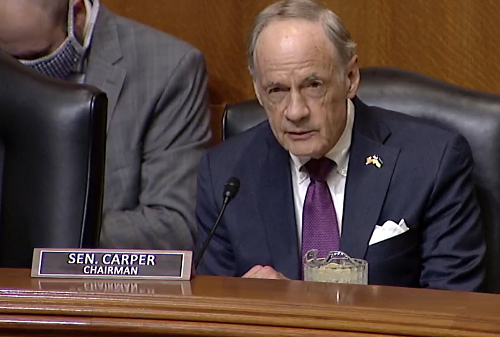A recent Senate Committee on Environment and Public Works hearing examined the impact of extreme heat on the nation’s transportation infrastructure and highlighted new funding resources available through the Infrastructure Investment and Jobs Act or IIJA to help combat that issue.
[Above image via the EPW video feed]
“The frequency, intensity, and duration of more intense heat waves, wildfires, and extreme weather across the United States have only gotten worse in recent years due in large part to human-caused climate change,” noted Sen. Tom Carper (D-DE), who chairs the EPW committee, in his opening statement. “In turn, this has put our nation’s transportation infrastructure, workforce, and travelers at greater risk of harm.”

He pointed out that extreme heat can impact the nation’s transportation infrastructure in many ways.
“For example, when temperatures reach triple digits, roadways can buckle, resulting in costly damage that disrupts travel and leads to unsafe road conditions,” Sen. Carper said. “In fact, it is estimated that the additional road maintenance and replacement costs caused by extreme heat could reach a total cost of $26 billion nationwide by 2040.”
Sen. Shelley Moore Capito (R-WV), ranking member on the EPW committee, added in her opening statement that the nation has witnessed a series of natural disasters over the last few years and how they’ve impacted transportation infrastructure.
“Catastrophic floods in California and Vermont, tornadoes in Arkansas and Mississippi, violent hailstorms in Texas, a hurricane made landfall in Florida, flash floods in my home state of West Virginia, and those horrible, massive fires in Hawaii,” she said. “The consequences of extreme weather are felt in both urban and rural communities year-round.”

Sen. Capito noted that those “varied extreme weather events” show that there is no “one-size-fits-all approach” to addressing infrastructure and resiliency issues – meaning that maintaining flexibility within federal-aid highway programs is “absolutely crucial” to ensuring that states can tackle their unique transportation needs head on.
“One of the IIJA’s new programs that is especially relevant to today’s hearing is the Promoting Resilient Operations for Transformative, Efficient, and Cost-Saving Transportation or PROTECT program [that] provides a renewed focus on improving the resiliency of our transportation infrastructure to withstand extreme weather,” she said. “[That] program is important because it is a new tool we have to ensure we are preparing for the future, and not just responding to the aftermath of extreme weather.”
Aimee Flannery – global principal for transportation risk and resilience for consulting firm Jacobs Solutions – testified at the hearing on behalf of the American Council of Engineering Companies and expounded on the benefits of increased federal support in this area.
“Nearly two years since the passage of the IIJA, the transportation industry has, for the first time, dedicated funding to address resilience from natural hazards,” she said in her testimony, pointing out that the PROTECT formula program includes over $7 billion in funding, with a further $1.4 billion within its discretionary grant program.

“State agencies and their partners such as Metropolitan Planning Organizations, cities, and counties have been working diligently to develop Resilience Improvement Plans and prioritized lists of projects for their highway systems to reduce risk from natural hazards and improve system resilience,” Flannery said.
“The state agency professionals I work with note that this [PROTECT program] is a game changer and allows them to begin to establish programs and processes to integrate resilience into their day-to-day practice, while ensuring that their solutions meet the needs of their individual resilience challenges,” she pointed out. “States also appreciate the flexibility of existing and new programs such as PROTECT to allow them to combine funding streams to accomplish greater returns on investments made.”
Flannery added the transportation industry as a whole continues to make investments in research, training, and guidance to support transportation engineering and planning professionals – specifically citing the Transportation Research Board and the American Association of State Highway and Transportation Officials for publishing guidance on a range of topics related to climate resilience.
“For example, research is underway to develop resilience metrics, standardize methods of assessing system risk and resilience from natural hazards, and estimate the level of effort required to update national design standards via the National Cooperative Highway Research Program,” she noted.
Flannery pointed out, however, that incorporating climate resilience as a “standard practice” within the transportation project planning process “has yet to be fully integrated” but change is happening.
“To that end, future transportation reauthorization efforts from this committee to spur the incorporation of resilience into practice could include supporting the industry to better understand risk tolerance and what is the acceptable level of resilience for the range of facilities that serve our surface transportation needs,” she said. “Establishing such criteria would help to better understand what potential changes to design standards and material specifications may be needed to address climate resilience.”
 Top Stories
Top Stories
USDOT Makes $1.5B Worth of BUILD Grants Available
December 19, 2025 Top Stories
Top Stories

